Ron Coleman, Tamarack Cellars
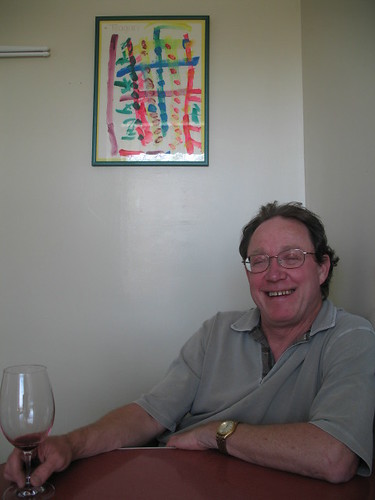
I've made it pretty clear in the past that I'm no fan of numerical wine ratings. Seems, in fact, to be all the rage these days with us bloggers to say so as often as possible. Kinda like how it never seems to get old for everyone to sneer at oaky Chardonnay. I could type a list a foot-and-a-half long list right now on why the 100 point system is out of whack, makes retailers lazy and leads the wine drinking public way astray.
But what kinda Cork Demon would I be if I couldn't rebel against all doctrine, including my own?
On the walls of Ron Coleman's old firehouse-cum-winery are the blurbs of Wine Spectator, enlarged and framed, their high scoring digits pouncing out at you from every wall. Walking into this, I was more than a little concerned that I was in for a set of tongue-thrashing fruit bombs when I reached the tasting table.
Big they were, to be sure. But they had something special: movement. And by that I mean an elegant progression of flavors through the palate. This made me less wary of the effusion of praise. Hell, maybe there are high scoring wines that have more than power. Huh.
Ron himself just so happened on the scene, looking quite tired from the barrage of tourists there for a bit of vino before moving on to the weekend hot-air balloon extravaganza. He gave me a quick tour of the place before sitting down with me.
Interview with Ron Coleman, Tamarack Cellars
C&D: Tell me about this building.
Ron: This base that we're on was an Army Air Corps base. In WWII it was set up overnight because they had another base, but they needed a place for take-off and touch-downs for the B-25's. This was a B-25 bomber training base. The crews left here and went to Burma and to Northern England and to bomb Hitler, you know, so real heroes. When the war ended the base was shut down, but all these buildings were left. This building was the fire station for the whole base.
How did it all begin, you and wine?
The first bottle I remember impressing me was a '68 Charles Krug, in 1971. So I've been into wine for a long time. First vintage I remember buying was the '73 Germans, they were really good. Then the '74 California Cabs came along, and I just became a wine guy. For many years, just a wine lover, through the seventies and the eighties.
What did you do at the time?
Worked for the railroad. My wife was going to medical school, and I quit the railroad and became a wine wholesaler in Seattle in the eighties while she was in med school. At the end of school she transferred for residency to Milwaukee, she's an eye surgeon. We moved there and I became a sommelier at an old hotel...and sold wine during the day at a kinda yuppie grocery store, did that for four years. When we got done with that, I really wanted to make wine. She wanted to be a small town doctor. So in '93, we moved to Walla Walla. I started working at wineries...as a cellar rat. In '98, we started this winery. I made 300 cases in '98...we kept increasing, and we're up to about 10,000 cases now.
You said earlier that you had originally wanted to top out at two or three thousand cases. What happened?
 You know, making wine's addictive. You get opportunities to get into vineyards that you really want to be into, and it just kinda snowballs. I think in some ways, though, it hurt me to lose that focus. I've always admired the fact that you can go to Bordeaux and drive to the winery and...you don't go to Chateau Palmer and ask, "What winery should I taste?" It's the wine. I like a wide array of wines, I get bored easily. So I end up making a lot of different kinds of wines.
You know, making wine's addictive. You get opportunities to get into vineyards that you really want to be into, and it just kinda snowballs. I think in some ways, though, it hurt me to lose that focus. I've always admired the fact that you can go to Bordeaux and drive to the winery and...you don't go to Chateau Palmer and ask, "What winery should I taste?" It's the wine. I like a wide array of wines, I get bored easily. So I end up making a lot of different kinds of wines.What's your definition of a well-made glass of wine?
Wine's about balance. It's easy to focus just on one tune in wine, it's harder to juggle a lot of balls at once, and have a lot of things going on in the mouth. It's easy to get a great entry (on the palate) and no middle. Sometimes you get a middle and no entry. Easy to get one of the three, you know. It takes three things: entry, middle, finish. I'm old, I've drank wine for a long time. I don't like in-your-face, big, powerful, over-the-top wines. I like wines that taste finished. I tasted a lot of wines that, to me...I feel like I want to take them back to the winery and finish them. I like wines that are very elegant, very long, balanced.
I have to ask you, like everybody, about terroir.
It's French for "Hang on to your wallet, here we come." It's the latest bit of bullshit that people put between knowledge of wine and romance. It's overplayed and misunderstood. At worst, it's thought of by most people as just the taste of dirt from one specific spot. I'll see wine writers go to...we've got vineyards over on Red Mountain. Two famous ones, Ciel du Cheval and Klipsun. And because they're famous and because they're stylistically different, wine writers'll go out there, taste the wines and talk to the owners and they'll say, "Look at the terroir! We're just across the road and the terroir is completely different!" That Red Mountain is basically the same terrain. The dirt is very similar, the climate's very similar. What's different is the way they're farmed. And they just never see that. They never see the science behind it that really creates the differences.
Tell me more.
If you go into Klipsun and walk through you'll see...the way they trellis it...is very hedged, very exposed, really cut down. You go into Ciel du Cheval and Jim does something completely unusual with a big tall fan. And to begin with, the plants are twice as tall. They sprawl on one side. It's very unique, the way Jim farms. What they call 'terroir' is really just an expression, in my opinion, of Jim's ability to grow fruit in a certain specific style. The fruit, the wine is very elegant from Ciel du Cheval, Klipsun they're very powerful and strong.
So this is about canopy management, you're saying.
Exactly. And people don't understand why wines taste the ways they do. And instead of really learning, really delving into it, they fall back on romantic terms. Not a popular theory, is it?
(Unfortunately, I ended up in Utah. You know how they are with their near-beer. Sigh.)
But at last, a break from the interviews, the hobnobbing, the tourists...and on to some of the most heart-poundingly fabulous terrain in all the world...Southern Utah.
So there I was in Moab, on my trusty rented steed McCourt, when...what the hell?
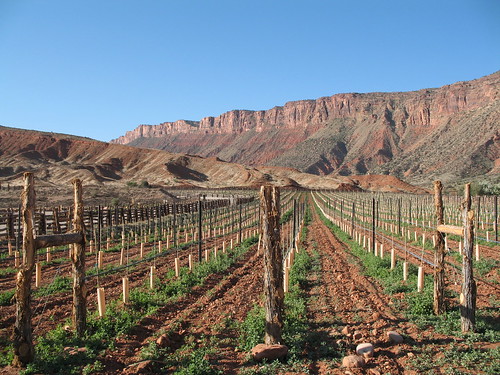
Well, I'll just be damned. Syrah in the desert. Stay tuned.
Clinks.

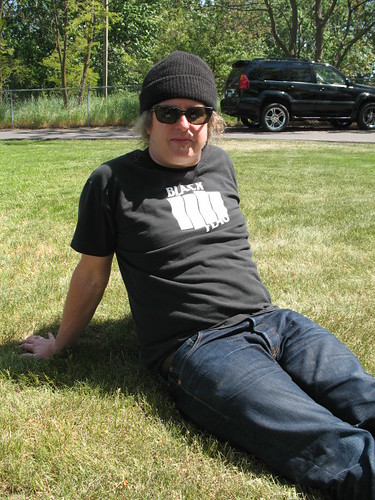 Always wondered what this guy looked like. Back in Austin, his House Wine, a Cab/Syrah blend behind a plain white label with fat black lettering, sells out by the palletful. I'd heard some things about him: some connection to rock bands, maybe he was a roadie or something, but now he was all about syrah. Gotta check that one out.
Always wondered what this guy looked like. Back in Austin, his House Wine, a Cab/Syrah blend behind a plain white label with fat black lettering, sells out by the palletful. I'd heard some things about him: some connection to rock bands, maybe he was a roadie or something, but now he was all about syrah. Gotta check that one out.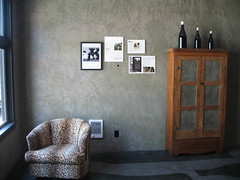 The inside of the white 'K'd barn is where Charles has got the rock and roll going on. An inner sitting room is cleverly designed and accented with a leopard skin chair. While the outside's whitewashed, the inside is painted completely black. His barrels stack up on one wall behind the tasting table they've set up for the weekend. Candles flicker everywhere, and you get the feeling you're in someone's personal shrine. Which you are. A current release of a rather kickass high end Syrah/Cab blend bears the name 'The Creator', and a sketch of Charles wearing a halo over his frizzy grey mane. Kinda egotistical, but I'm gonna give it to him. The wine's the real deal. Big and luscious but somehow unheavy, and some of the earthiest American syrah I've had yet.
The inside of the white 'K'd barn is where Charles has got the rock and roll going on. An inner sitting room is cleverly designed and accented with a leopard skin chair. While the outside's whitewashed, the inside is painted completely black. His barrels stack up on one wall behind the tasting table they've set up for the weekend. Candles flicker everywhere, and you get the feeling you're in someone's personal shrine. Which you are. A current release of a rather kickass high end Syrah/Cab blend bears the name 'The Creator', and a sketch of Charles wearing a halo over his frizzy grey mane. Kinda egotistical, but I'm gonna give it to him. The wine's the real deal. Big and luscious but somehow unheavy, and some of the earthiest American syrah I've had yet.
 I looked at the property and said, "Damn, this place is ugly, but maybe I can do something". When I moved here, this place was trashed. There was no vineyard here, it was all above ground irrigation, it was just awful. But it was a beautiful spot, the soils were good, and a good location, and I said, this is gonna be the place.
I looked at the property and said, "Damn, this place is ugly, but maybe I can do something". When I moved here, this place was trashed. There was no vineyard here, it was all above ground irrigation, it was just awful. But it was a beautiful spot, the soils were good, and a good location, and I said, this is gonna be the place.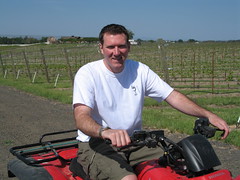 Down the road from Pepperbridge, past an orchard of apple trees strapped to trellises is Va Piano Vineyards, where Jean-Francois Pellet has sent me to talk to his good friend Justin Wylie. I turn into the drive that runs between the newly leafy rows and here comes one of those ATV things, bright red, with a fit of dust trailing. "Park your car, and hop on, I'll take you for a tour," Justin says. I'm wondering how I'm supposed to hoist my butt on this little ride, but somehow I can just fit behind him and brace myself on the rack. Off we go.
Down the road from Pepperbridge, past an orchard of apple trees strapped to trellises is Va Piano Vineyards, where Jean-Francois Pellet has sent me to talk to his good friend Justin Wylie. I turn into the drive that runs between the newly leafy rows and here comes one of those ATV things, bright red, with a fit of dust trailing. "Park your car, and hop on, I'll take you for a tour," Justin says. I'm wondering how I'm supposed to hoist my butt on this little ride, but somehow I can just fit behind him and brace myself on the rack. Off we go.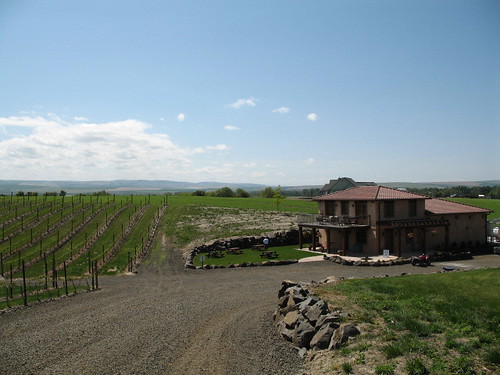 It's a stunning day, baby blue sky, long rolling hills; the closest of which belong to Justin and his family. Justin is eager to tell me everything there is to know about his land. He reminds me of a kid with that "I made this!" enthusiasm.
It's a stunning day, baby blue sky, long rolling hills; the closest of which belong to Justin and his family. Justin is eager to tell me everything there is to know about his land. He reminds me of a kid with that "I made this!" enthusiasm.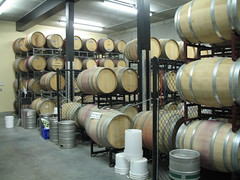 Justin has built himself a sort of co-op. The ample cellar below the tasting room houses the barrels of five other aspiring winemakers, some of whom seemed to have left big careers to do this wine thing: a former CNN producer, an ex-lawyer, a Master Sommelier. While Justin blended barrel samples in the glass for me, I watched as a couple of these guys bustled about, taking their own samples for analysis or sealing bottles with wax guns. The resident grey cellar cat supervises from a perch atop a stack of cases.
Justin has built himself a sort of co-op. The ample cellar below the tasting room houses the barrels of five other aspiring winemakers, some of whom seemed to have left big careers to do this wine thing: a former CNN producer, an ex-lawyer, a Master Sommelier. While Justin blended barrel samples in the glass for me, I watched as a couple of these guys bustled about, taking their own samples for analysis or sealing bottles with wax guns. The resident grey cellar cat supervises from a perch atop a stack of cases.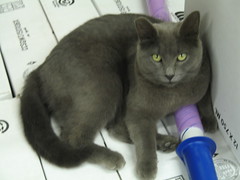 Above in the tasting room, unframed canvases line the wall, each a scene of Italian landscape rendered in vivid colors. My inner art hound craved one, but the price tag was too high. The pieces are done by Fr. Bruno Segatta who was once the Dean at Gonzaga University in Spokane. Justin tells me that Fr. Segatta donates part of the proceeds of the sale of these paintings to an orphanage in Nairobi. There are a couple of them so fetching that I'd buy 'em even if the money went to the NRA, but I just didn't have a grand on me right then.
Above in the tasting room, unframed canvases line the wall, each a scene of Italian landscape rendered in vivid colors. My inner art hound craved one, but the price tag was too high. The pieces are done by Fr. Bruno Segatta who was once the Dean at Gonzaga University in Spokane. Justin tells me that Fr. Segatta donates part of the proceeds of the sale of these paintings to an orphanage in Nairobi. There are a couple of them so fetching that I'd buy 'em even if the money went to the NRA, but I just didn't have a grand on me right then. Everything here is authentic. It's a 7500 square foot building. We had an architect design it. The windows are all hand made, the doors are all hand made, and given that aged look. We've really tried to capture a sense of quality, and more important, a time period. It gives the allusion that it's been here for a long, long time.
Everything here is authentic. It's a 7500 square foot building. We had an architect design it. The windows are all hand made, the doors are all hand made, and given that aged look. We've really tried to capture a sense of quality, and more important, a time period. It gives the allusion that it's been here for a long, long time. Once I saw the labels again, I immediately remembered both
Once I saw the labels again, I immediately remembered both 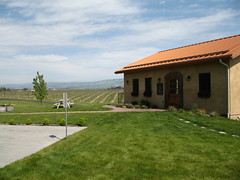 The openness. Coming from Switzerland...it's a great country, but it's small and everyone's on top of each other. And look at that. Look at the view we have here. It's acres and acres of land. There's more people moving in here, but it's still pretty open.
The openness. Coming from Switzerland...it's a great country, but it's small and everyone's on top of each other. And look at that. Look at the view we have here. It's acres and acres of land. There's more people moving in here, but it's still pretty open. This is a good question. I think the difference is...we try to be as soft as possible, but at the same time we don't want our hands tied if one year we have a problem. We might have to spray with something a little stronger, and we understand that we might lose three years of trying to reestablish beneficial insects and other things, but we believe--and this is where the economical and actually the social aspects come in--that our goal is to make good wine, and we cannot lose a crop or have a bad crop and make good wine, at the end of the day.
This is a good question. I think the difference is...we try to be as soft as possible, but at the same time we don't want our hands tied if one year we have a problem. We might have to spray with something a little stronger, and we understand that we might lose three years of trying to reestablish beneficial insects and other things, but we believe--and this is where the economical and actually the social aspects come in--that our goal is to make good wine, and we cannot lose a crop or have a bad crop and make good wine, at the end of the day.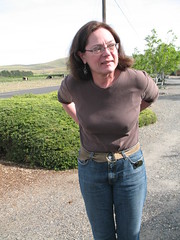 Over the mountains and through the high desert went Maggie and I last week to the expansive Yakima Valley. The Yakima doesn't share the press that Walla Walla gets, and that's so not fair, since a fair portion of wineries in the latter and elsewhere purchase fruit from it. It's Bordeaux variety country: Merlot, Cabernet Sauvignon and Sauvignon Blanc a-plenty. But, who's that, hiding in the corner? Is that
Over the mountains and through the high desert went Maggie and I last week to the expansive Yakima Valley. The Yakima doesn't share the press that Walla Walla gets, and that's so not fair, since a fair portion of wineries in the latter and elsewhere purchase fruit from it. It's Bordeaux variety country: Merlot, Cabernet Sauvignon and Sauvignon Blanc a-plenty. But, who's that, hiding in the corner? Is that 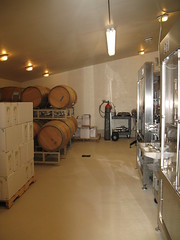 I ended up going to UC Davis to study nutrition, and during my convoluted path that most young people take, I decided that the malting and brewing class would be really fun to take, I love beer. Many of my classmates were also involved in wine classes, so I discovered that there was a major I could move to. I had all the chemistry already, organic microbiology and all that you need. So I changed my major to fermentation science. Graduated with that degree, got a job right away with a large winery. Then in the late seventies I got a job with Chateau St. Michelle here in Washington, they were expanding, they'd been purchased by U.S. Tobacco Company, and they hired a lot of young people with wine industry qualifications. That's where I met my husband Clay. In 1983 we started Chinook with no money and lots of ideas.
I ended up going to UC Davis to study nutrition, and during my convoluted path that most young people take, I decided that the malting and brewing class would be really fun to take, I love beer. Many of my classmates were also involved in wine classes, so I discovered that there was a major I could move to. I had all the chemistry already, organic microbiology and all that you need. So I changed my major to fermentation science. Graduated with that degree, got a job right away with a large winery. Then in the late seventies I got a job with Chateau St. Michelle here in Washington, they were expanding, they'd been purchased by U.S. Tobacco Company, and they hired a lot of young people with wine industry qualifications. That's where I met my husband Clay. In 1983 we started Chinook with no money and lots of ideas.
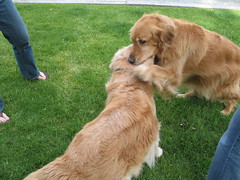 We drink some of everything. When we make that weekly trip to Seattle, one of us has the shopping assignment...sometimes, it's something typical of the blend we're working on. And then, the people who sell our wine, what are they excited about? It's interesting to know that, too.
We drink some of everything. When we make that weekly trip to Seattle, one of us has the shopping assignment...sometimes, it's something typical of the blend we're working on. And then, the people who sell our wine, what are they excited about? It's interesting to know that, too.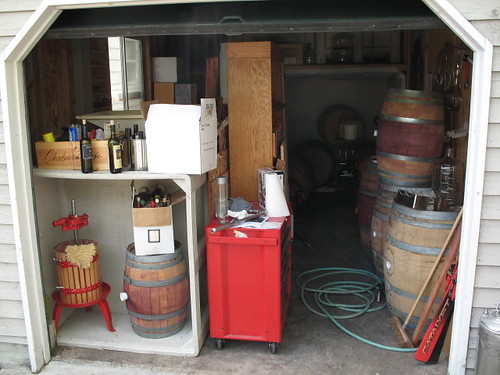
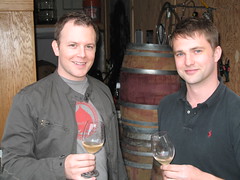
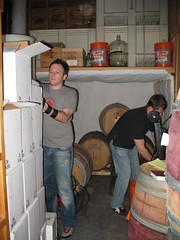
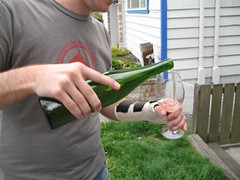
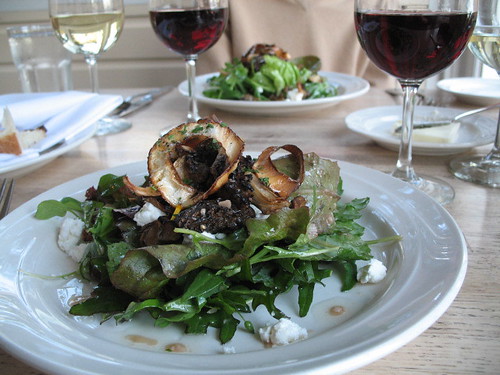 I'm here to testify today: Not only is the Inn at Ship Bay on Orcas Island a suh-weet vacation destination, but chef/gardener/proprietor Geddes Martin and crew do killer springtime salads, first courses and entrees that make the whole Orcas Island thing complete.
I'm here to testify today: Not only is the Inn at Ship Bay on Orcas Island a suh-weet vacation destination, but chef/gardener/proprietor Geddes Martin and crew do killer springtime salads, first courses and entrees that make the whole Orcas Island thing complete.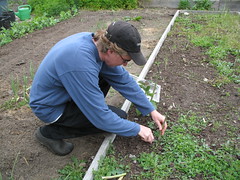
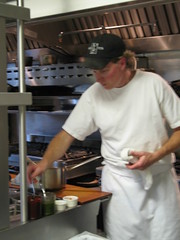 I'd been trying to catch up with Geddes for a couple of days. He was power washing a fence at one point; didn't want to bother him doing that. I saw him down in his arugula patch, but by the time I got down there, he was already gone. Finally I nudged my way into the kitchen and asked him a few questions while he cut up fresh ducks.
I'd been trying to catch up with Geddes for a couple of days. He was power washing a fence at one point; didn't want to bother him doing that. I saw him down in his arugula patch, but by the time I got down there, he was already gone. Finally I nudged my way into the kitchen and asked him a few questions while he cut up fresh ducks.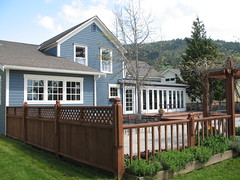 But the inn itself is far from neglected. The Martins have repainted, reappointed and relandscaped. The result is a cozy retreat on a cliff that overlooks the bay with appropriately priced rooms and...did I mention the killer restaurant?
But the inn itself is far from neglected. The Martins have repainted, reappointed and relandscaped. The result is a cozy retreat on a cliff that overlooks the bay with appropriately priced rooms and...did I mention the killer restaurant? For many small Pinotphile winemakers in the Willamette, the grape is a like a puzzle that can be put together many different ways to achieve different pictures. Choice of clones, in which chunk of land to grow those particular clones, out of which block of that chunk of land to harvest, and which of the wines from the particular block in the specific chunk of land to choose to bear the label.
For many small Pinotphile winemakers in the Willamette, the grape is a like a puzzle that can be put together many different ways to achieve different pictures. Choice of clones, in which chunk of land to grow those particular clones, out of which block of that chunk of land to harvest, and which of the wines from the particular block in the specific chunk of land to choose to bear the label.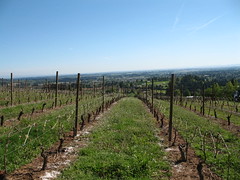 Well, I like wine. I moved here in 1980 from Indiana, and we had a small, burgeoning wine industry. I had a friend, I used to go pick peaches at his place every August. And picking peaches, we'd walk by his small Pinot Noir vineyard, pick the peaches, which were incredible, and walk back. I also had a friend who had the equipment so I thought, okay, for very little money, we could try making wine. That was back in 1985. We made ten gallons, it was a blast seeing the stuff change from this incredible fruit...ferments and turns into this raw, yeast filled, somewhat tart alcoholic substance. And then it mellows out, goes through malolactic fermentation and turns into beautiful Pinot Noir. I was hooked, through that first batch. I made more the next year, more the next year, pretty soon I was making the legal limit of what they'll let you make at home. After a few years of doing that I started helping out at a local winery, Elk Cove. I enjoy making wine so that gave me a chance to help do it on an industrial scale. I used to take my vacation from my engineering job--a day in the winery, a day back in the office--through harvest, as a volunteer. After doing that for a couple of years, they brought on David O'Reilly to be their marketing guy. We used to share food...at harvest, that was the ethic, to share food and wine. He got to try the wines I was making, and after trying the zinfandel a couple times, he said, why don't we get a couple of tons and make it into a commercial wine? It's got a story, it's good wine, he thought we might be able to sell it. Year by year, we added vineyards and grew. Eventually I ran out of time to do both engineering and winemaking. So I dropped the engineering.
Well, I like wine. I moved here in 1980 from Indiana, and we had a small, burgeoning wine industry. I had a friend, I used to go pick peaches at his place every August. And picking peaches, we'd walk by his small Pinot Noir vineyard, pick the peaches, which were incredible, and walk back. I also had a friend who had the equipment so I thought, okay, for very little money, we could try making wine. That was back in 1985. We made ten gallons, it was a blast seeing the stuff change from this incredible fruit...ferments and turns into this raw, yeast filled, somewhat tart alcoholic substance. And then it mellows out, goes through malolactic fermentation and turns into beautiful Pinot Noir. I was hooked, through that first batch. I made more the next year, more the next year, pretty soon I was making the legal limit of what they'll let you make at home. After a few years of doing that I started helping out at a local winery, Elk Cove. I enjoy making wine so that gave me a chance to help do it on an industrial scale. I used to take my vacation from my engineering job--a day in the winery, a day back in the office--through harvest, as a volunteer. After doing that for a couple of years, they brought on David O'Reilly to be their marketing guy. We used to share food...at harvest, that was the ethic, to share food and wine. He got to try the wines I was making, and after trying the zinfandel a couple times, he said, why don't we get a couple of tons and make it into a commercial wine? It's got a story, it's good wine, he thought we might be able to sell it. Year by year, we added vineyards and grew. Eventually I ran out of time to do both engineering and winemaking. So I dropped the engineering. Well, first of all, if you look at all my wines, most of them are vineyard designated. It's interesting to me, and others, to have the land express itself in wines. So if the vineyards I get have fruit that makes distinctly good wine, it gets a label. I mean, you tasted three different Gewurtztraminers, they were all different, yet they were made in exactly the same fashion. And Pinot Noir is said to be the one that expresses terroir best...you know, the difference between sites?
Well, first of all, if you look at all my wines, most of them are vineyard designated. It's interesting to me, and others, to have the land express itself in wines. So if the vineyards I get have fruit that makes distinctly good wine, it gets a label. I mean, you tasted three different Gewurtztraminers, they were all different, yet they were made in exactly the same fashion. And Pinot Noir is said to be the one that expresses terroir best...you know, the difference between sites?
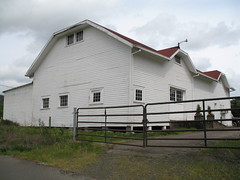 He took me around and told me a bit about the history of the grounds. "This is old Oregon," he said. And it was: the Springbrook Farms B&B across the yard is an historic monument, and its hazelnut orchard has been surviving worms for upwards of 70 years. The white barn itself has a full century behind it. Jim told me that when he moved in, the structure was listing 12 degrees and had to be righted before anything else could go on inside.
He took me around and told me a bit about the history of the grounds. "This is old Oregon," he said. And it was: the Springbrook Farms B&B across the yard is an historic monument, and its hazelnut orchard has been surviving worms for upwards of 70 years. The white barn itself has a full century behind it. Jim told me that when he moved in, the structure was listing 12 degrees and had to be righted before anything else could go on inside. Jim walked around it and gave each paddle a light push until all were swinging silently back and forth. Below the boat and covered with a layer of dust were water-blue wooden cutouts, mostly thin planks, but some with human shapes. This kinetic structure was once in the Smithsonian, but needed a home. Local artist Larry Kirkland hung it in his buddy's barn.
Jim walked around it and gave each paddle a light push until all were swinging silently back and forth. Below the boat and covered with a layer of dust were water-blue wooden cutouts, mostly thin planks, but some with human shapes. This kinetic structure was once in the Smithsonian, but needed a home. Local artist Larry Kirkland hung it in his buddy's barn. The wasp is a talisman as well; Jim nearly died during a severe allergic reaction after a sting. "That which doesn't kill you, et cetera," he said. He doesn't have to tell you that he's traveled the world, been a business advisor to the Peace Corps, and biked across America for you to sense that he's already done big things. "I used to be in commercial real estate, drive the expensive sports car," he admits. But clearly that wasn't the direction he desired.
The wasp is a talisman as well; Jim nearly died during a severe allergic reaction after a sting. "That which doesn't kill you, et cetera," he said. He doesn't have to tell you that he's traveled the world, been a business advisor to the Peace Corps, and biked across America for you to sense that he's already done big things. "I used to be in commercial real estate, drive the expensive sports car," he admits. But clearly that wasn't the direction he desired. Like most of the other Pinotphiles, Jim's got several single vineyard wines in barrel. Rather than the usual, efficient labeling of the barrel's contents with a marker, each barrel has a thin wooden plank with the name of the vineyard in the same calligraphic hand as the official logo: Shea, Temprance Hill, Montazi. Nice touch.
Like most of the other Pinotphiles, Jim's got several single vineyard wines in barrel. Rather than the usual, efficient labeling of the barrel's contents with a marker, each barrel has a thin wooden plank with the name of the vineyard in the same calligraphic hand as the official logo: Shea, Temprance Hill, Montazi. Nice touch. The name Harry Peterson-Nedry goes down in the Cork and Demon Hall o' Fame under the category 'Most Willing to Shave Off a Chunk of Time Under Pressure'. He met me over a cup of joe on his way to a very important-sounding meeting in Portland, yet never appeared rushed or annoyed, and even stayed into the time I estimated it would take him to get to downtown. What a champ.
The name Harry Peterson-Nedry goes down in the Cork and Demon Hall o' Fame under the category 'Most Willing to Shave Off a Chunk of Time Under Pressure'. He met me over a cup of joe on his way to a very important-sounding meeting in Portland, yet never appeared rushed or annoyed, and even stayed into the time I estimated it would take him to get to downtown. What a champ.
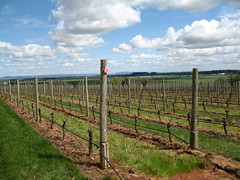
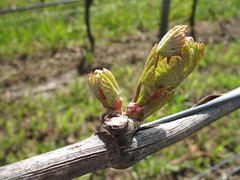 Pinot Noir is the most reflective variety of terroir. It reflects the site differences, I think, more than any other varietal in the red spectrum. Reisling is that for the white spectrum. Terroir is critical in a place like Burgundy and critical in a place like Oregon. We have different soils, different folding of land masses, sheltering...the geographies give you different climatic conditions, the soils are very diverse. When people think of the Willamette valley they think of very rich growing conditions here and they're thinking of bottom land. Of course, everything in Oregon is on hillsides. What we get is not a consistent bottom land of topsoil that was brought in from Idaho, Montana and Washington millions of years ago, what we get are some of the uplifts of ocean sediment, sediment blown in from later times, we get a lot of volcanic material, up to 25 different strata. So the complexity of the terroir is almost mind-boggling.
Pinot Noir is the most reflective variety of terroir. It reflects the site differences, I think, more than any other varietal in the red spectrum. Reisling is that for the white spectrum. Terroir is critical in a place like Burgundy and critical in a place like Oregon. We have different soils, different folding of land masses, sheltering...the geographies give you different climatic conditions, the soils are very diverse. When people think of the Willamette valley they think of very rich growing conditions here and they're thinking of bottom land. Of course, everything in Oregon is on hillsides. What we get is not a consistent bottom land of topsoil that was brought in from Idaho, Montana and Washington millions of years ago, what we get are some of the uplifts of ocean sediment, sediment blown in from later times, we get a lot of volcanic material, up to 25 different strata. So the complexity of the terroir is almost mind-boggling.


